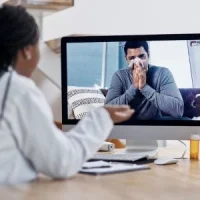Pharmacy benefit manager and healthcare provider, Optum (Eden Prairie,
MN, USA), recently released a report on U.S. healthcare providers’ telehealth
use and experience. The research was conducted on behalf of Optum by survey
company, Qualtrics (Seattle, WA, USA) and included insights gathered by 240
providers. Following the onset of the COVID-19 pandemic, providers adopted
telehealth on a massive scale. The research shows that while most providers enjoy
the convenience telehealth offers them and their patients, room exists for
improvement. As the COVID-19 pandemic continues, many providers are considering
whether and how to continue offering virtual care. Most respondents (93%) indicated
that they will continue to use telehealth after the pandemic.
About 75% of survey respondents are primary care physicians. When asked what patient care is delivered by telehealth, healthcare providers answered:
- Conduct primary care visits (75%)
- Conduct chronic care visits (72%)
- Order prescription refills (64%)
- Conduct COVID-19 screenings (39%)
- Conduct urgent care visits (38%)
- Address mental health concerns (36%)
- Conduct follow-up after a procedure or surgery care (28%)
Regarding the modality of the how telehealth is delivered, real-time communication channels overshadowed asynchronous channels. Respondents said they conduct telehealth visits by video (88%), phone visits (80%), secure messaging (30%), email (12%), text messaging (7%), and chatbots (3%). Providers felt that their patients preferred traditional scheduling via phone calls (86%), followed by online (51%), and in-person (26%) scheduling.
Sixty-four percent of respondents would describe telehealth with the word ‘convenient’, whereas 28% felt frustrations. Of those feeling frustration, they summed up their frustration as follows:
- The quality of care they can provide (58%)
- Managing patient expectations (55%)
- Technical aspects associated with telehealth (50%)
Although 64% of the surveyed providers felts satisfied with telehealth, the report did identify areas for improvement in the patient and clinician experience.
To address this, the report makes the following recommendation: ’The top two priorities for providers in improving telehealth, when seen together, call for bridging the digital divide. Providers saw the No. 1 priority as offering telehealth training to patients who are less digitally savvy. Ongoing telehealth training for clinicians and their staff ranked second.’
Source: UnitedHealth Group
Image Credit: iStock










